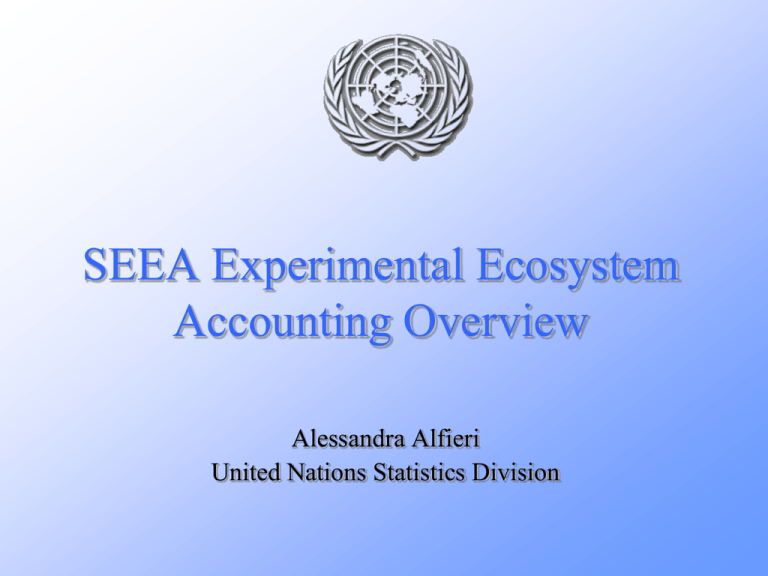SEEA Experimental Ecosystem Accounting Overview Alessandra Alfieri United Nations Statistics Division
advertisement

SEEA Experimental Ecosystem Accounting Overview Alessandra Alfieri United Nations Statistics Division Rationale for Experimental Ecosystem Accounting • Envisaged as part of SEEA revision process initiated in 2007 under the management of the Committee of Experts on EnvironmentalEconomic Accounting • Complements SEEA Central Framework • Not intended to be an international statistical standard but initial conceptual framework for accounting for ecosystem assets and associated services from which testing and research can be undertaken Blending underlying concepts • Conceptual model is ecosystem accounting formed from established concepts in • Ecology • Ecological economics • National accounts • Statistical measurements Why an accounting approach? • Accounting is funded on defined relationships between stocks and flows • The conceptual relationships and associated measurement boundaries are present in physical and monetary terms • Derivation of aggregates is an outcome of defined relationships and use of common measurement units • Within measurement boundaries the accounts are comprehensive and internally consistent Basic Accounting Model • Stocks = Ecosystem Assets • Spatial area • Fixed characteristics (e.g., slope, altitude) • Variable characteristics (e.g., land cover, biodiversity) • Flows • Intra-ecosystem (within ecosystem) • Inter-ecosystem (between ecosystems) • Ecosystem services (to people) Basic Accounting Model Ecosystem asset (spatial area) Exchanges of products & social interactions Economic & other human activity Ecosystem services Human impacts Intra-ecosystem flows Economic & other human activity Human impacts Ecosystem processes Ecosystem characteristics Ecosystem asset (spatial area) Ecosystem services Ecosystem processes Intra-ecosystem flows Inter-ecosystem flows Ecosystem characteristics Model related to flows of ecosystem services Individual & societal wellbeing Benefits SNA & non-SNA Human inputs (e.g. labour, produced assets) Ecosystem services Ecosystem processes Ecosystem characteristics Intra-ecosystem flows ECOSYSTEM ASSET Inter-ecosystem flows Ecosystem assets • Two perspectives on environmental assets Individual environmental assets -Timber resources - Aquatic resources - Mineral & energy res - Soil resources - Land - Water resources Bio-physical environment Ecosystem assets “Combinations of biotic communities and their abiotic environment functioning together in a spatial area” - excludes mineral & energy resources Ecosystem Asset Measures Capacity of ecosystem asset to generate ecosystem services Expected ecosystem service flows (for a given basket of ecosystem services) Ecosystem condition (quality of ecosystem characteristics relative to reference condition) Ecosystem extent (spatial area/size of ecosystem) Spatial Area Representation Ecosystem Accounting Unit LCEU type A BSU LCEU type B LCEU type C LCEU type A Key Considerations • • • • • • Multi-disciplinary nature Accounting approach benefits Physical and monetary accounting Complements SEEA Central Framework Continued research and testing needed Potential to meet policy demands Multi-disciplinary nature • Conceptual model in ecosystem accounting formed from established concepts in • • • • Ecology Economics National accounts Statistical measurement • Inputs from many disciplines in drafting • Cooperation among disciplines necessary in testing and research • Important role for National Statistical Offices Accounting Approach Benefits • Broad coverage related to defined set of components • Comprehensive (not selective) measurement within boundaries • Integrated and coherent relationships between stocks and flows • Basis for organizing information • Potential for aggregation and consistent time series Physical and Monetary Accounting • Physical accounting relevant and important in assessment of changes in ecosystems • May be sufficient for many purposes • Monetary accounting allow the linkages of the physical flows with the monetary flows • Valuation remains challenging but it is important to clarify valuation principles of SNA and beyond Complements SEEA Central Framework • Compilation of land accounts is a building block for ecosystem accounting • Measurement of individual assets inform ecosystem conditions and services • Combined presentations • Link information on environmental pressures (e.g. flows of natural inputs of water and energy and flows of residuals of air emissions and waste) to environmental impacts • Link responses (environmental protection expenditures, taxes and subsidies) to ecosystem changes Continued Research and Testing Needed • Conceptually sound framework, providing broad platform for research & testing • Aspects requiring further research • Ecosystem degradation • Valuation approaches for accounting purposes • Need for testing across different ecosystems and countries • • • • Delineation of spatial units Classifications (spatial areas, ecosystem services) Selection of indicators Accounting tables and aggregation methods Potential to Meet Policy Demands • Framework for assessing environmental impact of economic activity • Can assist in answering key policy questions (e.g. trade-off analysis) • Integrated, multi-disciplinary framework suited to analysis of cross-cutting policy issues • Potential basis for monitoring international processes • Potential to scale to local, national and global levels Proposed Next Steps • • • • Research agenda implementation Testing in countries Formation of expert group Three areas of research • Physical ecosystem accounting • Monetary ecosystem accounting • Communication and dissemination





